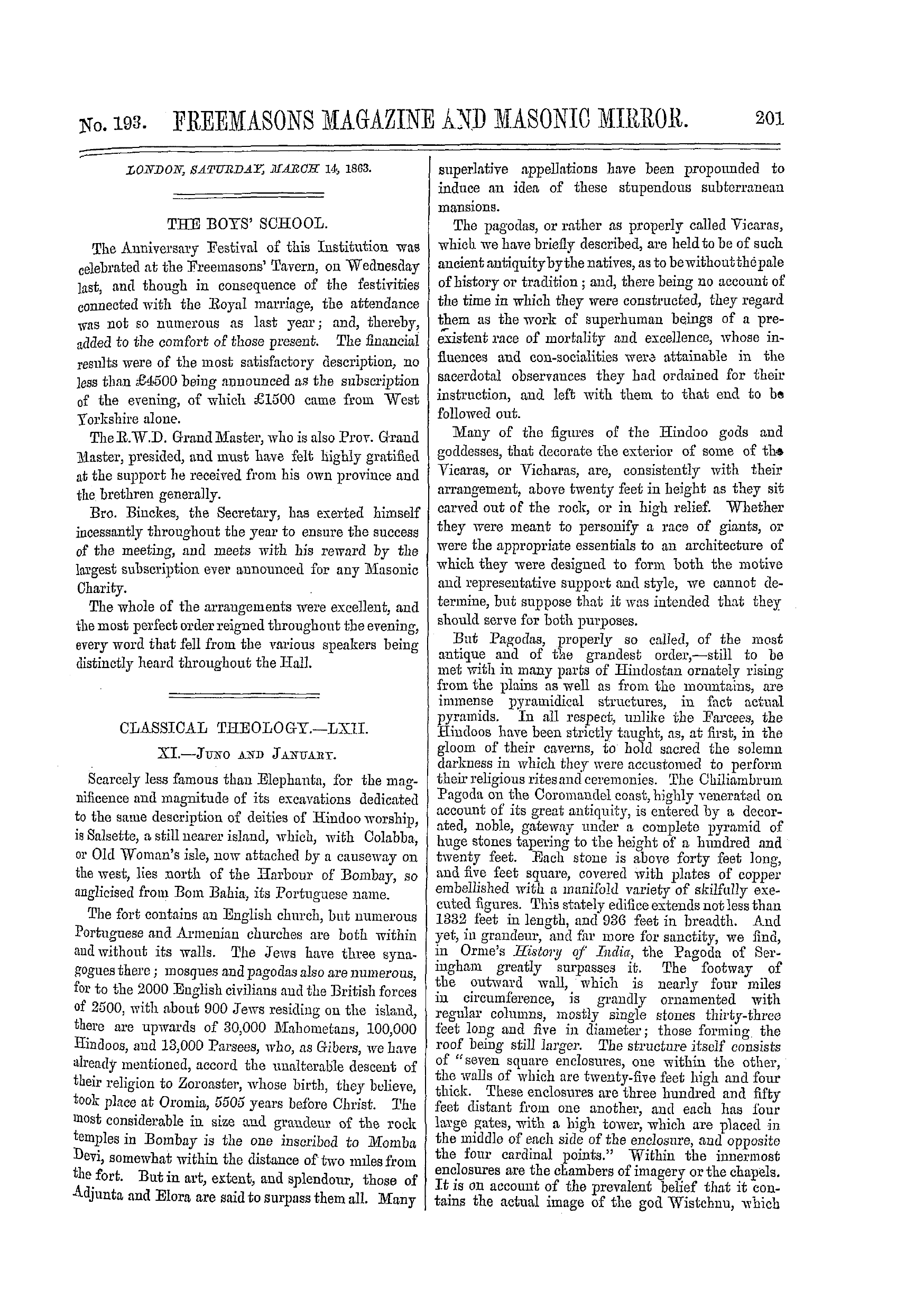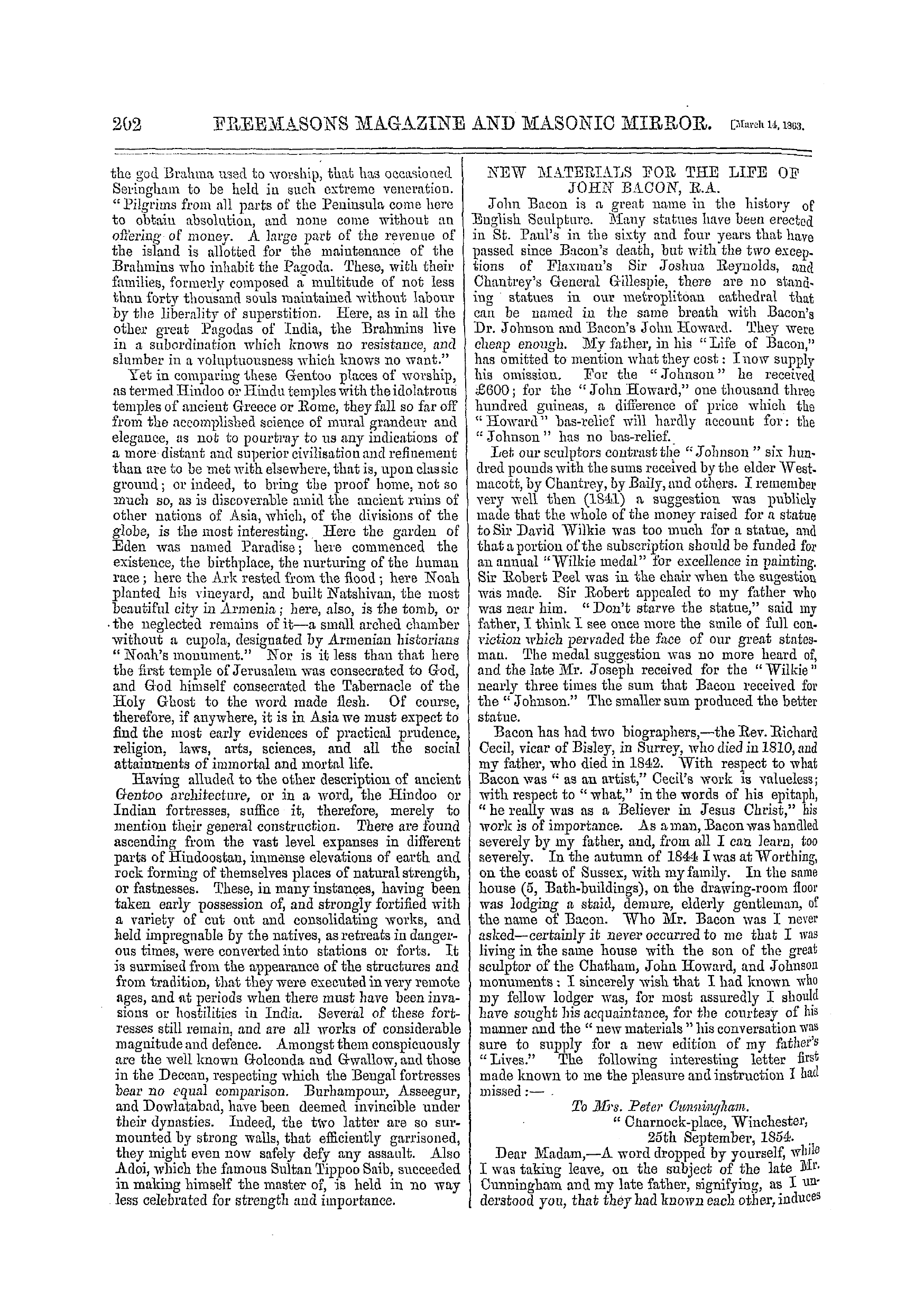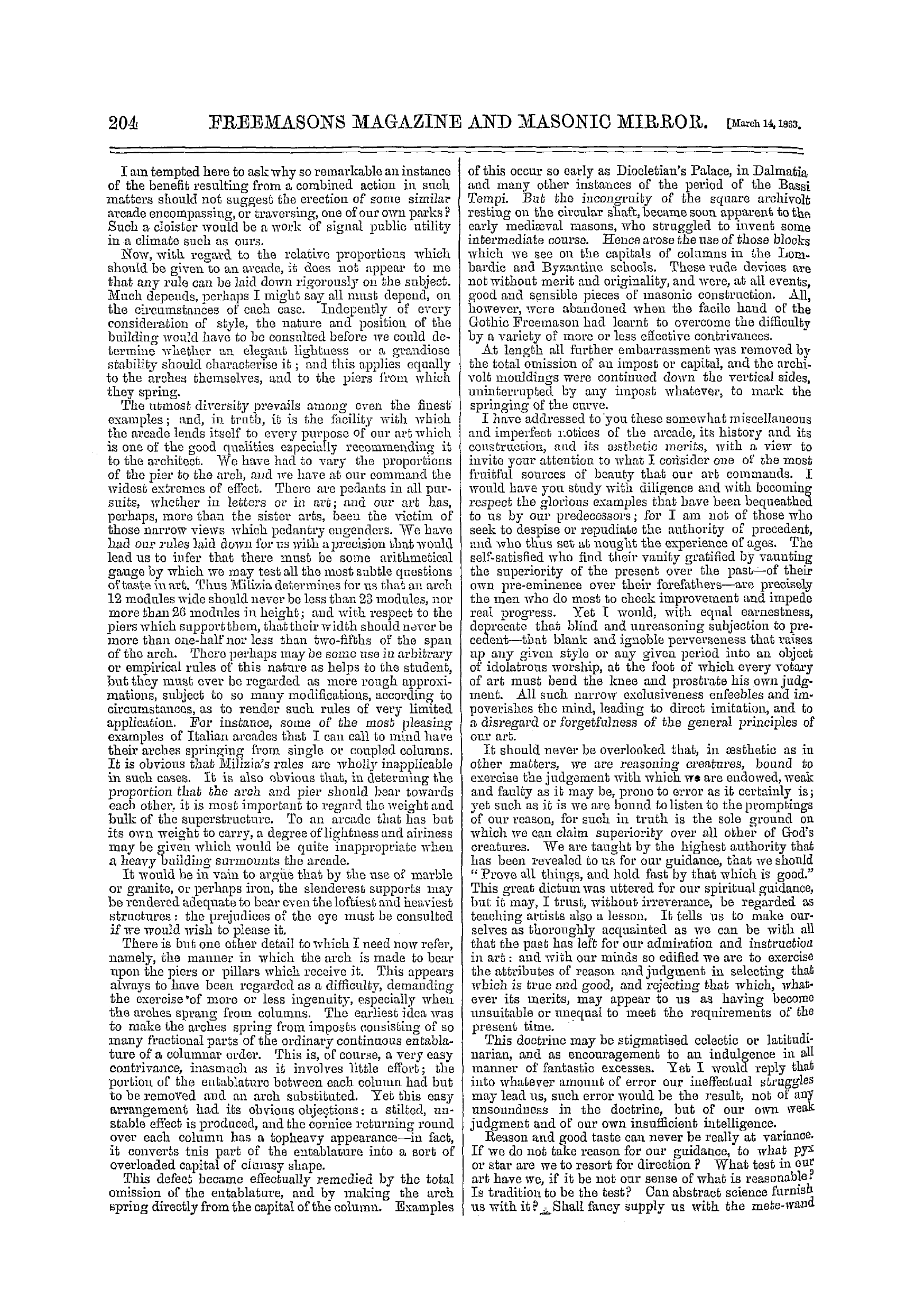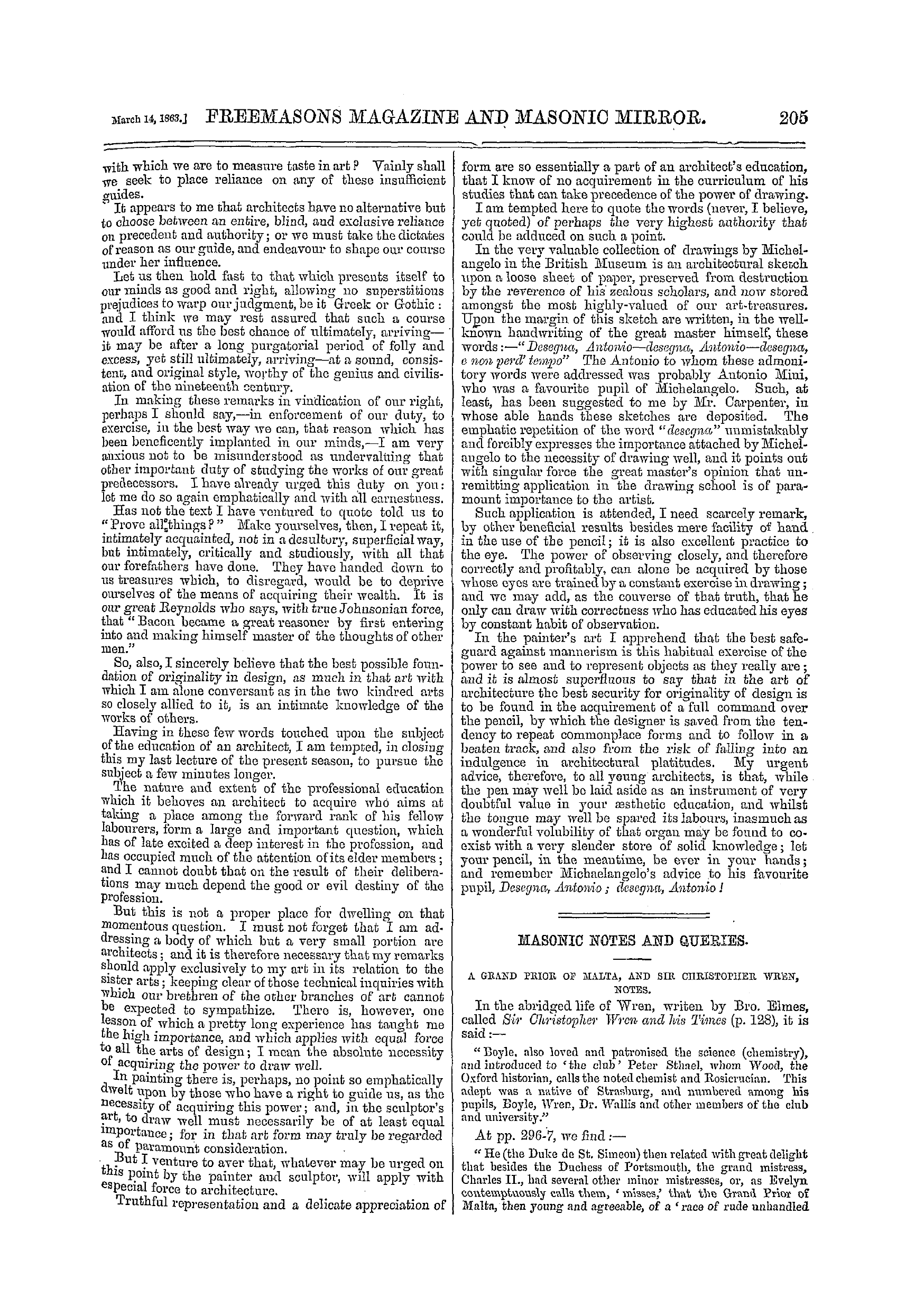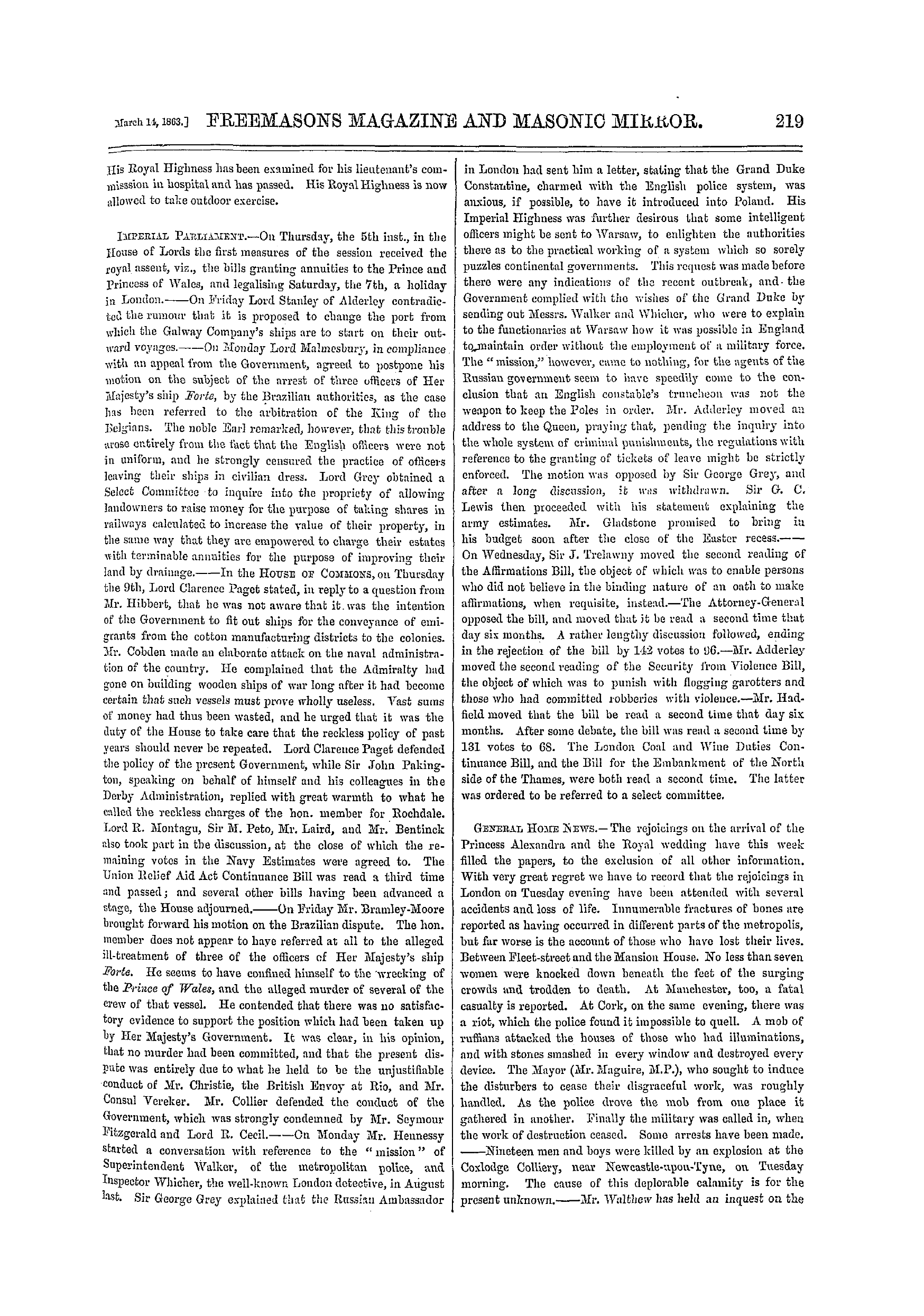-
Articles/Ads
Article ON THE ARCH AND ARCADES. ← Page 2 of 3 →
Note: This text has been automatically extracted via Optical Character Recognition (OCR) software.
On The Arch And Arcades.
I am tempted here to ask why so remarkable an instance of the benefit resulting from a combined action in such matters should not suggest the erection of some similar arcade encompassing , or traversing , one of our own parks ? Such a cloister would be a work of signal public utility in a climate such as ours . Now , with regard to the relative proportions which
should be given to an arcade , it does not appear to me that any rule can be laid down rigorously on the subject . Much depends , perhaps I might say all must depend , on the circumstances of each case . Indepently of every consideration of style , the nature and position of the building- would have to be consulted before we could determine whether an elegant lihtness or a grandiose
g stability should characterise it ; and this applies equally to the arches themselves , and to the piers from which they spring . The utmost diversity prevails among oven the finest examples ; and , in truth , it is the facility with which the arcade lends itself to every purpose of our art which is one of the good qualities especially recommending it
to the architect . We have had to vary the proportions of the pier to the arch , and we have at our command the widest extremes of effect . There are pedants in all parsuits , whether in letters or in art ; and our art has , perhaps , more than the sister arts , been the victim of those narrow views which pedantry engenders . We have bad our rules laid down for us with a precision that wonld
lead us to infer that there must be some arithmetical gauge by which we may test all the most subtle questions of taste mart . Thus Milizia determines for us that an arch 12 modules wide should never be less than 23 modules , nor more than 26 modules in height ; and with respect to the piers which support them , that their width should never be more than one-half nor less than two-fifths of the span of the arch . There perhaps may be some use in arbitrary or empirical rules of this nature as helps to the student , but they must ever be regarded as mere rough
approximations , subject to so many modifications , according to circumstances , as to render such rules of very limited applicatiou . For instance , some of the most pleasing examples of Italian arcades that I can call to mind hare their arches springing from single or coupled columns . It is obvious that Milizia's rules are wholly inapplicable in such cases , lb is also obvious that , in determing the
proportion that the arch and j } ier should bear towards each other , it is most important to regard the weight and bulk of the superstructure . To an arcade that has bnt its own weight to carry , a degree of lightness and airiness may be given which would be quite inappropriate when a heavy building surmounts the arcade . It would be iu vain to argue that by the use of marble
or granite , or perhaps iron , the slenderest supports may be rendered adequate to bear even the loftiest and heaviest structures : the prejudices of the eye must be consulted if we would wish to ] 3 lease it . There is but one other detail to which I need now refer , namely , the manner in which the arch is made to bear upon the piers or pillars whichreceive it . This appeal's
, always to have been regarded as a difficulty , demanding the exercise * of more or less ingenuity , especially when the arches sprang from columns . The earliest idea was to make the arches spring from imposts consisting of so many fractional parts of the ordinary continuous entablature of a columnar order . This is , of course , a very easy contrivance , inasmuch as it involves little effort ; the
portion of the entablature between each column had but to be removed and an arch substituted . Yet this easy arrangement had its obvious objections : a stilted , unstable effect is produced , and the cornice returning round over each column has a topheavy appearance—in fact , it converts tnis part of the entablature into a sort of overloaded capital of ciurasy shape . This defect became effectually remedied by the total omission of the entablature , and by making the arch spring directly from the capital of the column . Examples
of this occur so early as Diocletian's Palace , iu Dalmatia and many other instances of the period of the Bassi Tempi . But the incongruity of the square arehivolt resting on the circular shaft , became soon apparent to ths early mediaeval masons , who struggled to invent some intermediate course . Hence arose the use of those blocks which we see on the capitals of columns in the
Lombardic and Byzantine schools . These rude devices are not without merit and originality , and were , at all events , good and sensible pieces of masonic construction . All , however , were abandoned when the facile hand of the Gothic Freemason had learnt to overcome the difficulty by a variety of more or less effective contrivances . At length all further embarrassment was removed by
the total omission of an impost or capital , and the arehivolt mouldings were continued down the vertical sides , uninterrupted by any impost whatever , to mark the springing of the curve . I have addressed to ' you these somewhat miscellaneous and imperfect notices of the arcade , its history and its construction , and its aesthetic meiits , with a view to
invite your attention to what I coiisider one of the most fruitful sources of beauty that our art commands . I would have you study with diligence and with becoming respect the glorious examples that have been bequeathed to us by our predecessors ; for I am not of those who seek to despise or repudiate the authority of precedent , and who thus set at nought the experience of ages . The
self-satisfied who find their vanity gratified by vaunting the superiority of the present over the past—of their own pre-eminence over their forefathers—are precisely the men who do most to check improvement and impede real progress . Yet I would , with equal earnestness , deprecate that blind and unreasoning subjection to precedent—that blank and ignoble perverseness that raises up any given style or any given period into an object of idolatrous worship , at the foot of which every votary
of art must bend the knee and prostrate his own judgment . All such narrow exclusiveness enfeebles and impoverishes the mind , leading to direct imitation , and to a disregard or forgetful ness of the general principles of our art . It should never be overlooked that , in aesthetic as in other matters , we are reasoning creatures , bound to
exercise the judgement with which \ T « are endowed , weak and faulty as it may be , prone to error as it certainly is ; yet such as it is we are bound to listen to the promptings of our reason , for such in truth is the sole ground on which we can claim superiority over all other of God's creatures . We are taught by the highest authority that has been revealed to us for our guidance , that we should
' ' Prove all things , and hold fast by that which is good . " This great dictum was uttered for our spiritual guidance , but it may , I trust , without irreverance , be regarded as teaching artists also a lesson . It tells us to make ourselves as thoroughly acquainted as we can be with all that the past has left for our admiration and instruction in art : and with our minds so edified we are to exercise
the attributes of reason and judgment iu selecting that which is true and good , and rejecting that which , whatever its merits , may appear to us as having become unsuitable or unequal to meet the requirements of the present time . This doctrine may be stigmatised eclectic or latitudinarian , and as encouragement to an indulgence in all
manner of fantastic excesses . Yet I would reply that into whatever amount of error our ineffectual strugg les may lead us , such error would be the result , not of any unsoundness in the doctrine , but of our own weak judgment and of our own insufficient intelligence . Reason and good taste can never be really at variance . If do not take for guidanceto what
we reason our , pyx or star are we to resort for direction ? What test in our art have we , if it be not our sense of what is reasonable . Is tradition to be the test ? Can abstract science furnish us with it ? , Shall fancy supply us with the mete-wand
Note: This text has been automatically extracted via Optical Character Recognition (OCR) software.
On The Arch And Arcades.
I am tempted here to ask why so remarkable an instance of the benefit resulting from a combined action in such matters should not suggest the erection of some similar arcade encompassing , or traversing , one of our own parks ? Such a cloister would be a work of signal public utility in a climate such as ours . Now , with regard to the relative proportions which
should be given to an arcade , it does not appear to me that any rule can be laid down rigorously on the subject . Much depends , perhaps I might say all must depend , on the circumstances of each case . Indepently of every consideration of style , the nature and position of the building- would have to be consulted before we could determine whether an elegant lihtness or a grandiose
g stability should characterise it ; and this applies equally to the arches themselves , and to the piers from which they spring . The utmost diversity prevails among oven the finest examples ; and , in truth , it is the facility with which the arcade lends itself to every purpose of our art which is one of the good qualities especially recommending it
to the architect . We have had to vary the proportions of the pier to the arch , and we have at our command the widest extremes of effect . There are pedants in all parsuits , whether in letters or in art ; and our art has , perhaps , more than the sister arts , been the victim of those narrow views which pedantry engenders . We have bad our rules laid down for us with a precision that wonld
lead us to infer that there must be some arithmetical gauge by which we may test all the most subtle questions of taste mart . Thus Milizia determines for us that an arch 12 modules wide should never be less than 23 modules , nor more than 26 modules in height ; and with respect to the piers which support them , that their width should never be more than one-half nor less than two-fifths of the span of the arch . There perhaps may be some use in arbitrary or empirical rules of this nature as helps to the student , but they must ever be regarded as mere rough
approximations , subject to so many modifications , according to circumstances , as to render such rules of very limited applicatiou . For instance , some of the most pleasing examples of Italian arcades that I can call to mind hare their arches springing from single or coupled columns . It is obvious that Milizia's rules are wholly inapplicable in such cases , lb is also obvious that , in determing the
proportion that the arch and j } ier should bear towards each other , it is most important to regard the weight and bulk of the superstructure . To an arcade that has bnt its own weight to carry , a degree of lightness and airiness may be given which would be quite inappropriate when a heavy building surmounts the arcade . It would be iu vain to argue that by the use of marble
or granite , or perhaps iron , the slenderest supports may be rendered adequate to bear even the loftiest and heaviest structures : the prejudices of the eye must be consulted if we would wish to ] 3 lease it . There is but one other detail to which I need now refer , namely , the manner in which the arch is made to bear upon the piers or pillars whichreceive it . This appeal's
, always to have been regarded as a difficulty , demanding the exercise * of more or less ingenuity , especially when the arches sprang from columns . The earliest idea was to make the arches spring from imposts consisting of so many fractional parts of the ordinary continuous entablature of a columnar order . This is , of course , a very easy contrivance , inasmuch as it involves little effort ; the
portion of the entablature between each column had but to be removed and an arch substituted . Yet this easy arrangement had its obvious objections : a stilted , unstable effect is produced , and the cornice returning round over each column has a topheavy appearance—in fact , it converts tnis part of the entablature into a sort of overloaded capital of ciurasy shape . This defect became effectually remedied by the total omission of the entablature , and by making the arch spring directly from the capital of the column . Examples
of this occur so early as Diocletian's Palace , iu Dalmatia and many other instances of the period of the Bassi Tempi . But the incongruity of the square arehivolt resting on the circular shaft , became soon apparent to ths early mediaeval masons , who struggled to invent some intermediate course . Hence arose the use of those blocks which we see on the capitals of columns in the
Lombardic and Byzantine schools . These rude devices are not without merit and originality , and were , at all events , good and sensible pieces of masonic construction . All , however , were abandoned when the facile hand of the Gothic Freemason had learnt to overcome the difficulty by a variety of more or less effective contrivances . At length all further embarrassment was removed by
the total omission of an impost or capital , and the arehivolt mouldings were continued down the vertical sides , uninterrupted by any impost whatever , to mark the springing of the curve . I have addressed to ' you these somewhat miscellaneous and imperfect notices of the arcade , its history and its construction , and its aesthetic meiits , with a view to
invite your attention to what I coiisider one of the most fruitful sources of beauty that our art commands . I would have you study with diligence and with becoming respect the glorious examples that have been bequeathed to us by our predecessors ; for I am not of those who seek to despise or repudiate the authority of precedent , and who thus set at nought the experience of ages . The
self-satisfied who find their vanity gratified by vaunting the superiority of the present over the past—of their own pre-eminence over their forefathers—are precisely the men who do most to check improvement and impede real progress . Yet I would , with equal earnestness , deprecate that blind and unreasoning subjection to precedent—that blank and ignoble perverseness that raises up any given style or any given period into an object of idolatrous worship , at the foot of which every votary
of art must bend the knee and prostrate his own judgment . All such narrow exclusiveness enfeebles and impoverishes the mind , leading to direct imitation , and to a disregard or forgetful ness of the general principles of our art . It should never be overlooked that , in aesthetic as in other matters , we are reasoning creatures , bound to
exercise the judgement with which \ T « are endowed , weak and faulty as it may be , prone to error as it certainly is ; yet such as it is we are bound to listen to the promptings of our reason , for such in truth is the sole ground on which we can claim superiority over all other of God's creatures . We are taught by the highest authority that has been revealed to us for our guidance , that we should
' ' Prove all things , and hold fast by that which is good . " This great dictum was uttered for our spiritual guidance , but it may , I trust , without irreverance , be regarded as teaching artists also a lesson . It tells us to make ourselves as thoroughly acquainted as we can be with all that the past has left for our admiration and instruction in art : and with our minds so edified we are to exercise
the attributes of reason and judgment iu selecting that which is true and good , and rejecting that which , whatever its merits , may appear to us as having become unsuitable or unequal to meet the requirements of the present time . This doctrine may be stigmatised eclectic or latitudinarian , and as encouragement to an indulgence in all
manner of fantastic excesses . Yet I would reply that into whatever amount of error our ineffectual strugg les may lead us , such error would be the result , not of any unsoundness in the doctrine , but of our own weak judgment and of our own insufficient intelligence . Reason and good taste can never be really at variance . If do not take for guidanceto what
we reason our , pyx or star are we to resort for direction ? What test in our art have we , if it be not our sense of what is reasonable . Is tradition to be the test ? Can abstract science furnish us with it ? , Shall fancy supply us with the mete-wand
